 |
| Archbishop Desmond Tutu and his wife Leah walking with His Holiness the Dalai Lama to the Main Tibetan Temple in Dharamsala, India, on February 10, 2012. Photo/Tenzin |
The
trip to Dharamsala to see the Dalai Lama’s own town McLeod Ganj, which became the seat of the Tibetan government in
exile in the fifties, had been planned for many months. My husband John and I,
had visited several Buddhist monasteries in other parts of India, such as
Sarnath, where Buddha is said to have held his first sermon to five monks. From
this day on Buddhism spread with enormous speed, first in India and from there
to huge parts of Asia and even to the rest of the world.
Sarnath
is very close to our ‘home town’ in India, which is Varanasi, where we are
closely cooperating with the DEVA/DISCC organization for underprivileged
children. DEVA, which is the name of the original organization, is a Hindu
organization, only in as far as the denomination counts at all. Castes, for one
thing, just do not exist to our friends who run the organization and children
or families are helped if they need help no matter which God or Gods they pray
to.
A few
years ago we also traveled to Gangtok in Sikkim in northeastern India, which is
heavily influenced by Buddhism from the closely situated Tibet. There are
Tibetan exile monasteries and also a smaller Tibetan exile center close to
Gangtok where monks and whole families have fled from Tibet ever since 1959.
Chinese invasion and Tibetan
rebellion and exile
Tibetan
Buddhists had been rebelling ever since the Chinese clamped down on their freedom
to exercise their religion, beginning in 1955. Armed conflict between Tibetan
rebellion forces and the Chinese army started in 1956 in a couple of provinces
and spread quickly to the Tibetan capital Lhasa. Guerrilla warfare lasted
through 1962. On March 10, 1959, a revolt erupted in Lhasa. On March 17
mortar shells were fired on the Dalai Lama’s palace, and it became obvious that
his life was in danger.
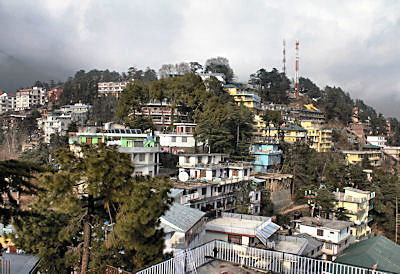 |
| View of McLeod Ganj on its hilltop above Dharamsala (Photo O'Neall) |
In
March 1959 the Dalai Lama escaped to India during a 14-day journey on foot
across the Himalayan mountains. He left Lhasa on March 17 with his family and an
entourage of 20 men. For quite some time there was no news as to his
whereabouts. On March 29, 1959, he sent a message to the Indian government
asking for permission to enter India and to seek asylum there. They
had to cross the Kyichu and the Tsangpo rivers, but due to the loyalty and
affectionate support of his people he
was able to find his way through a route which is, to say the least, extremely arduous.
The
exodus of Tibetans into India continues to this day. Out of the more than 6000
Buddhist monasteries in Tibet only 12 remain today. Particularly during the
Cultural Revolution (launched in 1966 and not really ended until 1971), there
was wholesale destruction of Tibetan buildings and religious artifacts.
"The Tibetan people were unwilling to accept
Chinese occupation. Unrest escalated throughout the decade after 1950,
culminating in the Tibetan Uprising of 1959. According to Chinese sources, 80,000
Tibetans died in Central Tibet alone during and immediately after the uprising.
It is estimated that since 1959, 1.5 million Tibetans have died as a direct
result of Chinese incursion into the country." (The Situation of Tibet)
Today, more than 200,000
Tibetans live in exile in India, Nepal, Bhutan and elsewhere.
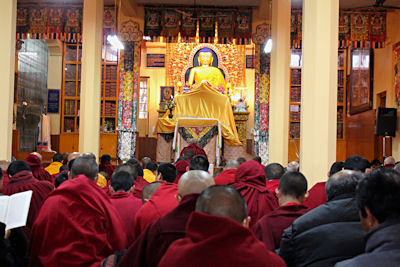 |
| The statue of Buddha in the center of the temple
(Photo O'Neall) |
The
Dalai Lama has his government in exile in McLeod Ganj in upper Dharamsala, even
though he recently gave up on his position as the political leader of Tibetans
in exile. He is now only the spiritual leader of Tibetan Buddhists. The goal is
to achieve autonomy for Tibet and he stresses that he is not a separatist.
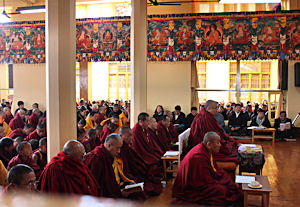 |
| Monks and tourists turned toward the statue of Buddha (Photo O'Neall) |
We were thrilled to
find out that, on our first day in McLeod Ganj, there was going to be a Memorial
service in the Temple for the refugees from Tibet in 1959. It was February 8,
but it was still a memorial service for the violent strike-down of the
rebellion on March 10, 1959.
The temple was crammed
with thousands of monks in their burgundy colored robes and shaved heads, many
of them actually, for once, wearing warm clothes under the robes – and
tourists with cameras.
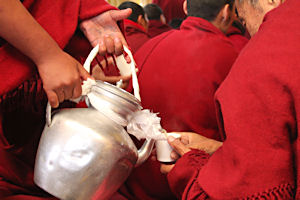 |
| Chai is being served (Photo O'Neall) |
Everybody was sitting cross-legged, even Westerners if
they could manage it, and after a while we were all served chai (marsala tea) by monks who were
walking around with huge ‘tea pots’. Very good and nice on a bone-chilling day
like this. And no segregation either. We were all allowed our paper cup of chai
and a small loaf of Tibetan bread.
In the evening there
was a candle light procession from the temple to the downtown
area of McLeod Ganj. We saw a glimpse of
it, the monks all carrying the candles you always see in their temples, walking
down towards the lower situated town.
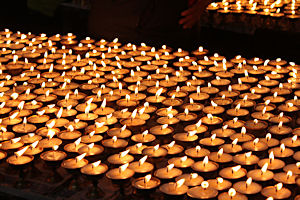 |
| Masses of candles inside the temple (Photo O'Neall) |
However, as we were watching them with
much awe, the snow began to fall and we escaped back inside. We later heard
that they had actually gone back up to the temple from the downtown, in the snow. And we
also found on the following morning, that the snow had continued to fall during
the night.
Many of the monks in their scanty robes seemed eerily resistant to
the cold. Lots of them were showing at least one bare arm, the way you usually
see the Dalai Lama himself portrayed. On a different occasion we asked a monk
how they could stand the cold weather in such thin clothing. They said they
learned ‘through meditation’.
 |
| Snow covered mountains above Dharamsala, the foothills of the Himalayas (Photo O'Neall) |
The Tibetan Children’s Village
in McLeod Ganj
Also
we got some very useful information from our hotel managers about a Tibetan
Children’s Village (TCV) close by. We immediately decided we were going to pay
a visit. After making the acquaintance of a cow and some lively monkeys
(tourists, watch out, they are thieves and they can bite too!), the whole Children’s
village opened up in front of us with its school buildings, its dormitories,
its playing fields and its management buildings. We were shown by a friendly
man to the building of the manager of the community, a woman named Tsering.
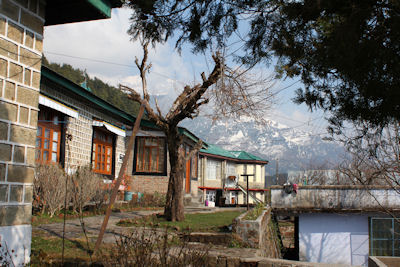 |
| The Tibetan Children's Village (Photo O'Neall) |
After having a long chat about the whole organization with this dignified and
extraordinarily friendly woman, we were given the grand tour of the precincts
by a younger woman, Lima. They all spoke excellent English. January and
February are winter vacation time so classes were not in session. We were shown
some of the very comfortable dormitories though and the whole village was beautiful and well-kept.
From TIBETAN CHILDREN'S VILLAGE SCHOOL, Dharamsala
Cantt.:
"On 17 May 1960, fifty-one
children arrived from the road construction camps in Jammu, ill and
malnourished. Mrs. Tsering Dolma Takla, the elder sister of His Holiness,
volunteered to look after them."
Tsering
(a common Tibetan man’s or woman’s name, meaning ‘Long Life’, first or last
name) told us how children, sometimes orphans, who have grown up in a Chinese
family can not even speak their own Tibetan language and know nothing about
their cultural heritage. They do, however, sometimes manage to secretly cross
over into India via the Himalayas, thus repeating the trek the Dalai Lama
himself made in 1959. An almost incredible feat, considering the height even of
the low passes of the Himalayas. The Chinese do allow a limited number of Tibetans
to leave their country, but the numbers are steadily decreasing. It is now down
to 500 a year, a mere trickle.
We
were greatly impressed by Tsering and by the whole organization. This TCV is
not financed by any foundation, but by various small organizations and by
people like you and me. Having a foster child who really needs your financial
help can be a most fulfilling experience.
This
 |
| The 'Baby Room' in the Tibetan Village (Photo O'Neall) |
community is extremely well equipped with Day Care Centers, a Health
Center, an Old Age Home, and they are more or less self-sufficient, with the
help they get from various international organizations.
Their
brochure states that:
“Today the TCV is a
self-contained integrated community with
family homes, schooling facilities, vocational training centers and teachers’
training centers.”
The
big surprise – Tsering also told us that the Dalai Lama himself was going to be
present at a very important event, together with his guest, Archbishop Desmond
Tutu from South Africa, on the very next day, February 10.
 |
| The very top of the Dalai Lama's temple could be seen from the terrace of our hotel (Photo O'Neall) |
Historic event in the
Temple of the Dalai Lama in McLeod Ganj
For the
big event when we were going to see the Dalai Lama, Desmond Tutu and his wife
Leah, we had received many different
opinions about when the event was to take place. Tsering had told us to be
there well before 10. At our hotel someone even said to be there at 9.
We
arrived in good time before 10 but were told on the way in that we were not
allowed to bring cameras. Oh well, so John had to go back downhill and up on
the hill where our hotel was and back again.
I
entered the crammed temple, the area more or less outside the temple building
itself under a huge canopy that had been added for this kind of huge event. Right away I saw Tsering sitting in the inner circle where she would have a very
good view of the stage. Here I was, over 6000 km from my home in France, a
total stranger to everybody, in a place that I had never really dreamed that I
would ever see in my life, in a Buddhist temple filled with thousands of monks,
nuns, Tibetan refugee families… and tourists. I then see a woman, Tsering of course,
turning her head towards me and saying “Where is John?” I should have been
thunderstruck, but somehow it all seemed fairly natural. I told her that he’d
had to go back to our hotel with our cameras. She said that I could probably
find some sitting room further down against the wall. With a big smile, as if I
was talking to an old friend, I asked her if she would please tell John where I
was, if she saw him coming in.
I
didn’t find any sitting room, but I was actually pleased to find standing room
at all. All in all we must have been standing up for a couple of hours for the event. John arrived
and told me that Tsering had, just as I had asked her, told him about where he
could find me. It all seemed somewhat unreal. Here we were in a country and a
small town and a Buddhist temple where we were as foreign and as anonymous as
can be. And here is a woman turning her head towards me, saying “Where is
John?”.
Some people must have been
waiting, standing or sitting cross-legged, literally for hours. But finally, just
after 11, something was stirring on the other side of the enormous seating area.
They had arrived. Dancers dressed in gorgeous black white and red costumes and
wearing face masks were starting their wild dance that we could see quite well.
A monk had given me his seat on a bench at one point and since he was nowhere
to be seen, I got up, with others, onto the bench and had a very good view of
what was going on. The dancing was accompanied by wild screams, somewhat pagan
sounding. Behind them came the notables, the Archbishop with a broad smile.
In October, the globe-trotting monk had called
off his South Africa visit, as it was "inconvenient" for the
government there to grant him a visa, the reason being that it had close ties with China. ‘They
later changed their minds on this but the preparations for Desmond Tutu’s trip to India had already
been made by then. The occasion for the meeting between the two great men was Tutu's 80th birthday.
The Dalai Lama spoke to his
fellow countrymen in Tibetan, and was afterwards translated into English for
those of us who didn’t understand Tibetan.
He spoke of the Archbishop
Desmond Tutu, his much honored guest:
"I welcome a great person today. He is a great and world-renowned
personality," the Dalai Lama said in his welcome address.
"He's a person who strongly advocates the importance of love,
compassion and equality. Even in his own country South Africa, he, along with
Nelson Mandela, has worked wholeheartedly through non-violence for equal rights
and genuine democracy," he said.
"The most important thing is that, even after the victory of democracy
and equal rights in his country, uneasy feelings of animosity and ill-will have
remained within people. Archbishop Tutu has made special efforts to reconcile
the people and do away with the feelings of unease and ill-will towards each
other."
The Dalai Lama appealed to his fellow Nobel laureate to pray for the
well-being of Tibetans suffering repression in Tibet.
"Tibetans are passing through a difficult period. Our sophisticated
and compassionate Tibetan culture is really facing a lot of difficulty,"
the elderly monk said.
"Another thing is that he works tirelessly for truth, honesty and
equality. He doesn't see any differences. Wherever there is abuse of human
rights or people's freedom is being snatched away, be it Burma or Tibet, he is
always the first person to speak against it," the Dalai Lama said about
Tutu.” (Dalai Lama is not a separatist: Archbishop Tutu)
In spite of the very serious words, the whole
event was marked by a lot of joking, and Desmond Tutu was the leader in the pleasantries. But
they both laughed a lot and you got the impression from both of these Nobel
Peace Prize laureates that they had just been leading quiet and good lives
since their childhood – whereas the truth is just the opposite.
Before getting into
the serious part of his speech, Desmond Tutu was kidding a lot about the
enormous popularity of the Dalai Lama. He said, ‘When he was in Seattle, there
were 60,000 people who had filled a football stadium to listen to him. But I’m
not jealous’, he said and repeated: ‘I’m not jealous.’ Laughs from the
audience. And, said Tutu, he can’t even speak English properly. Big laughs
again.
On a more serious note
he said that the Dalai Lama was the holiest man
he had ever met and that he
wanted to say to the Chinese government that ‘His Holiness is the
most peace-loving person on earth’.
“The discussion also saw Tutu and the Dalai Lama poking fun at each other
and making jokes at the expense of the South African and Chinese governments.
“Do you have an army? Why does the Chinese government fear you?” Tutu asked
the exiled Tibetan leader at one point.
“Tutu even managed to inject humour into his praise for the Dalai Lama,
describing him as:
"Someone who has amazed me, who has been in exile for over 15 years — you’d
expected him to be bitter and angry. He’s actually a bundle of joy. He’s in
fact quite mischievous, I have to warn him sometimes and say hey, hey, hey, the
cameras are on us, you need to behave like a holy man.” (memeburn)
Archbishop
Desmond Tutu continued, addressing the Chinese in speaking to the Tibetan
spiritual leader.
"I want to say to the Chinese government that His Holiness the Dalai
Lama is the most peace-loving person on this earth. I want to say to the
Chinese government that the Dalai Lama has no army, he cannot command his
people with guns, he's not a separatist," Tutu said at a public ceremony
organised by the Tibetan government-in-exile on his visit.
“Seeking more autonomy for the people of Tibet, Tutu said: "Please,
you leaders in Beijing, we beg you, allow Tibet to be what the constitution of
the People's Republic of China commits. The constitution allows for autonomy
and that is all His Holiness the Dalai Lama and his people want."
"We beg you and at the same time remind you
too that this is a moral universe. There is no way in which injustice,
oppression and evil can ever have the last word," the former archbishop
said in his message to the Chinese leadership.
“To the Tibetan people, he said: "We will visit you in Tibet. We will
enter a free Tibet." (Dalai Lama is not a separatist: Archbishop Tutu)
Afterword
This our 7th visit to India turned
out to be possibly the most eventful and exciting one of them all. There was
one surprise after another and our final visit to our ‘home town’ of Varanasi
was anything but a let-down. Our meeting with our foster child, 13-year-old Sampa,
an extremely bright girl who speaks excellent English, and her mother, Vimla, whom we
also know very well, was just one of the wonderful events. The get-togethers
with other old and new friends connected to DEVA/DISCC, some being total
surprises, made it a series of festive encounters while visiting various of the
very important DISCC projects.
I do believe India will be calling us back at
least once again.
_________________________
For a detailed background of the Chinese invasion of Tibet go to:
The Dalai Lama’s Press Statements (issued at Tezpur), 18th April, 1959

